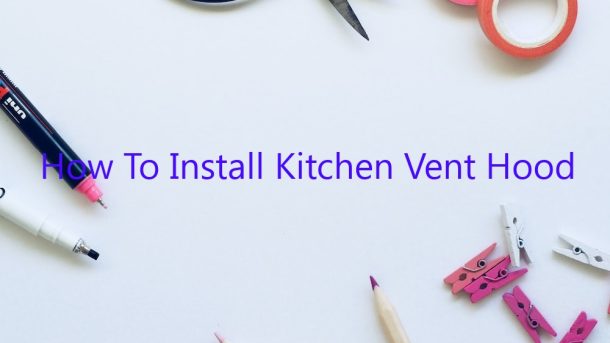If you’re remodeling your kitchen, or just need to replace an old vent hood, you may be wondering how to install a kitchen vent hood. Vent hood installation is a fairly straightforward process, but there are a few things you need to know before you get started.
The first step is to measure the space above your stove and oven to determine the size of vent hood you need. Be sure to include the width of the cabinets above the stove in your measurements. Once you have the right size vent hood, you can begin the installation process.
Most vent hoods attach to the ceiling with a metal bracket, so you’ll need to find a stud in the ceiling to attach the bracket. If you don’t have a stud in the right location, you can use a toggle bolt to attach the bracket to the drywall.
Next, you’ll need to connect the vent hood to the ductwork. Most vent hoods have a built-in damper that opens and closes to control the airflow. Be sure to install the vent hood so the damper is facing the correct direction.
Once the vent hood is installed, you can connect the power cord and test it to make sure it’s working properly. Then you’re ready to start cooking!
Contents
Can I install a vent hood myself?
Installing a vent hood can seem like a daunting task, but it can be done relatively easily by following the right instructions. In this article, we will provide you with a step-by-step guide on how to install a vent hood yourself.
First, you will need to purchase a vent hood that is the right size for your kitchen. Be sure to measure the dimensions of the space above your stovetop to ensure that you get a hood that will fit.
Once you have your vent hood, you will need to remove the old hood or range hood from your kitchen. This can be done by unscrewing the screws that hold it in place.
Then, you will need to install the new vent hood. Begin by attaching the brackets that come with the hood to the ceiling above your stovetop. Once the brackets are in place, you can then hang the hood from the brackets.
Next, you will need to connect the vent hood to the exhaust pipe. This can be done by threading the exhaust pipe into the hole on the back of the hood.
Finally, you will need to connect the power cord to the outlet. Be sure to consult the instructions that come with your vent hood to ensure that you are connecting the cord to the right outlet.
Once everything is connected, you can test the vent hood by turning it on. Be sure to allow the hood to run for a few minutes to ensure that it is working properly.
If you have any questions or concerns, be sure to consult a professional before attempting to install the vent hood yourself.
Do range hoods have to be vented outside?
Do range hoods have to be vented outside?
This is a question that many homeowners have, and the answer is not always clear. In some cases, it is necessary to vent a range hood to the outside of the home, but in other cases, it is not. Here, we will explore the reasons why a range hood might need to be vented and what homeowners can do if they do not have an outdoor venting option.
The first thing to consider is why a range hood needs to be vented in the first place. In most cases, the hood is vented because it is extracting heat and smoke from the cooking area. If this heat and smoke are not vented away from the home, they can cause problems like poor air quality, moisture damage, and even fires.
So, if a range hood is not vented to the outside, where is the heat and smoke supposed to go? In most cases, the hood will be vented to the interior of the home. This means that the heat and smoke will be extracted and then distributed throughout the house. While this might not be a problem in some cases, it can be dangerous in others. For example, if the range hood is vented into an enclosed space like a hallway or a room with no windows, the heat and smoke can quickly become overwhelming.
Another consideration is the type of range hood that is being used. Some hoods are designed to be vented to the exterior of the home, while others are not. If you are unsure whether your hood is designed to be vented externally, you can check the manufacturer’s instructions or contact the company directly.
If a homeowner does not have an option to vent the range hood to the outside, there are a few things that can be done. One option is to install a chimney or duct to the interior of the home. This can be a costly and time-consuming project, but it will allow the range hood to be vented safely.
Another option is to install a recirculating range hood. These hoods are designed to extract the heat and smoke from the cooking area and then filter it before recirculating it back into the kitchen. While this is not as effective as venting to the outside, it is a more affordable option and it is better than not having a range hood at all.
Ultimately, the decision of whether or not to vent a range hood to the outside of the home depends on a number of factors. If you are unsure whether your hood needs to be vented, it is best to consult with a professional.
How do you install an exhaust hood on a kitchen?
Installing an exhaust hood on a kitchen is not a difficult task, but it is important to follow the correct steps in order to ensure that the hood is properly installed and will function correctly. The first step is to measure the space above the cooktop in order to determine the size of the hood that you need. Once you have determined the size of the hood, you can purchase it and bring it home.
The next step is to install the bracket that will hold the hood in place. The bracket should be installed at the same height as the cooktop. Next, you will need to attach the exhaust duct to the hood. The duct should be attached to the back of the hood and should be as short as possible in order to reduce the amount of noise that the hood will make.
The hood can now be installed by placing it on the bracket and attaching it to the duct. Make sure that the hood is level before tightening the screws. The hood should be checked to make sure that it is working properly before installation is complete.
Is a range hood easy to install?
Range hoods are a convenient addition to any kitchen, as they help to keep the area clean by trapping cooking fumes and smoke. However, some people may be wondering if a range hood is easy to install.
In general, range hoods are relatively easy to install, especially if you are comfortable using a drill and screwdriver. The first step is to measure the area where you would like to install the range hood and then purchase a hood that is the right size.
Once you have the hood, the next step is to determine where the hood’s chimney will go. Most hoods have a chimney that extends out the back, so you will need to make sure there is enough room in your kitchen for it. You will also need to decide where the hood’s exhaust vent will go.
The next step is to install the hood’s chimney. This usually involves drilling holes in the wall and then screwing the chimney into place. Once the chimney is installed, you can attach the hood to it.
The final step is to install the exhaust vent. This usually involves drilling a hole in the wall and then attaching the vent to it. Once the vent is installed, you can plug it into the hood’s electrical outlet.
In general, range hoods are relatively easy to install, especially if you are comfortable using a drill and screwdriver. However, it is important to read the installation instructions carefully before beginning the installation process.
Does Home Depot install kitchen hood?
Home Depot does not install kitchen hoods. The company does, however, offer installation services for a variety of other home improvement projects. Customers who are interested in having a kitchen hood installed can find a qualified contractor through Home Depot’s website.
What type of duct is best for venting a range hood?
Range hoods are an important part of any kitchen, as they help to remove cooking fumes and smells from the room. In order to work properly, the range hood must be properly ventilated. This means that the hood must be connected to a duct that leads to the outside of the house.
There are a few different types of ducts that can be used for this purpose. The most common type is the metal duct. This type of duct is strong and can handle the high airflow that is created by a range hood. It is also resistant to moisture and corrosion, making it a good choice for a kitchen.
Another option is the flexible duct. This type of duct is made of plastic or rubber and is bendable, making it a good choice for tight spaces. However, it is not as durable as metal duct and is not as good at handling airflow.
The final option is the round duct. This type of duct is made of metal and is the most traditional type of duct. It is not as durable as the metal duct, but it is easier to install and less expensive.
So, what type of duct is best for venting a range hood? The answer depends on your needs and preferences. If you are looking for a durable, high-performance duct, then the metal duct is the best choice. If you are looking for a duct that is easy to install and less expensive, then the round duct is the best choice.
How high should a vent hood be over the stove?
When it comes to cooking, safety is always a top priority. One of the most important safety measures is ensuring that your stovetop is properly ventilated. This is why it’s important to know how high your vent hood should be over the stove.
According to the National Fire Protection Association, your vent hood should be at least 24 inches above the cooktop. This will ensure that the smoke and vapors from your cooking are properly vented and don’t create a fire hazard.
If your vent hood is too low, it won’t be able to properly vent the smoke and vapors. This could create a fire hazard and also cause smoke and fumes to build up in your kitchen.
If your vent hood is too high, it could be difficult to operate and may not be effective at venting the smoke and vapors.
It’s important to note that the height of your vent hood may vary depending on the type of stove you have. If you have a gas stove, your vent hood should be at least 36 inches above the cooktop. If you have a electric stove, your vent hood should be at least 30 inches above the cooktop.
When choosing a vent hood, be sure to select one that is the right height for your stove. This will ensure that your stove is properly ventilated and safe to use.




